
No-Till Farming: Way To More Sustainable Agriculture
In contrast to popular belief, no-till farming demonstrates that agriculturalists can get by just fine without plowing at the outset of field operations. In fact, the idea of zero tillage predates conventional (for now) tillage by a long shot. However, the reasons for not tilling today are different from those of millennia ago.
In bygone ages, the lack or primitive nature of cultivation tools dictated the use of no-till practices. At present, ecological concerns are mostly driving the approach’s implementation, thanks to the positive effects of no-till farming on soil and the environment in general.
What Is No-Till Farming?
No-till farming, sometimes called zero tillage, zero-till, or direct drilling, is an agriculture approach that eliminates the need to disturb the soil through tillage. No-till cultivation requires specialized equipment (disc seeders or agriculture drills) to make furrows, plant seeds, and cover them — everything at once, as opposed to double-passing the field after plowing. This way, the soil is subjected to minimal disturbance since it is dug exactly where the seed is supposed to fall. Planters also enable the application of fertilizer directly into the furrow through designated tubes, resulting in minimal fertilizer waste.
Conventional Vs. Organic No-Till Farming
No-till agriculture requires increased weed control that involves herbicide applications. In conventional no-till farming, synthetic herbicide use is a common solution to eliminate invasive plants. In contrast, organic zero-till agriculture does not make use of any synthetic inputs. As a solution, no-till organic farming relies on integrated weed control strategies such as crop rotation, cover crops mowed just before seed settles, grazing of livestock or poultry, and organic herbicides. By suppressing weeds through no-till farming without herbicides and other sparing methods, agriculture producers contribute to environmental protection, nature regeneration, and human health.
The no-till approach is fundamental to regenerative farming, which seeks to restore damaged soil to its original condition. To increase soil organic matter and fertility, organic no-till farming entails the following procedures:
- planting annual or winter-hardy cover crops in the fall;
- leaving cover crops unharvested till spring;
- killing the crops while simultaneously turning them into mulch with a roller crimper.
Benefits And Challenges Of No-Till Farming
No-till farming shows a lot of potential as a sustainable agricultural practice, promising benefits for both the environment and farmers’ bottom lines. However, farmers must carefully consider the challenges associated with weed control, disease management, and residue handling. Understanding local conditions and the unique requirements of various crops is crucial for the successful application of zero-till farming practices.
Benefits Of No-Till Farming
Maintaining soil health is just one of the advantages of no-till farming. Some of its further benefits are:
- Reduced expenses related to plowing the entire field. Modern machines allow sowing directly on the residue-covered strips instead. Furthermore, plants can benefit from the nutrients found in decomposed matter.
- Limited fossil fuel inputs for zero-till field operations: 2 to 6 gallons of diesel fuel per acre (19 to 56 liters per hectare), according to the U.S. Department of Agriculture .
- Shorter operation time. Sophisticated seeders do the job faster and complete it in a single field pass.
- Minimal human labor needed for tilling operations and maintaining tillage machines.
- Conserved soil moisture and decreased water spending due to slowed evaporation and low cracking.
- Eliminated herbicide leakage as a result of less frequent irrigation.
- Enhanced carbon sequestration by maintaining and building SOC (soil organic carbon).
With all these no-till farming benefits, more and more farmers are switching to the new method, encouraged, in particular, by the USDA conservation programs and economic standpoints. It should be noted that implementations vary across crops and farming regions. ERS research provides adoption data for separate crops from 2002 to 2017, which may be informative for those pursuing zero tillage .

Challenges Of No-Till Farming
Along with the numerous advantages, there are some possible disadvantages of no-till farming to consider before making the switch:
- An initial investment may be necessary for specialized agricultural machines and equipments such as planters, drills, and residue management machines.
- More sophisticated, integrated management approaches are required to eradicate pests and weeds.
- Crop diseases can overwinter and spread through residue left on the field. However, with strategic crop rotation and crop residue management, no-till farmers can sidestep this issue.
- Since soil recovery takes time, the positive effects of zero tillage will not be immediately noticeable.
When weighing no-till farming’s pros and cons, it’s also necessary to realize that the approach requires paying close attention to your area’s specific soil and weather patterns. But there’s absolutely nothing to be scared of. Affordable modern technologies, such as precision agriculture tools, might offer insights and helpful advice for adjusting the method to your local conditions.
Common Methods Of No-Till Farming
Unlike traditional plowing methods, which involve turning the top layer of soil over before planting, no-till methods strive to minimize or eliminate soil disturbance. But how can a farmer deal with the soil that cannot be disturbed? The following farming methods form the basis of the zero-till approach.
Field Mulching
The inability to mechanically eradicate weeds makes weed control crucial in no-till farming. Farmers address the issue by covering inter-rows with straw, dry hay, or another type of mulch. Mulch not only suppresses weeds, reducing their exposure to light, but also accumulates moisture and protects plant roots from the burning sun.
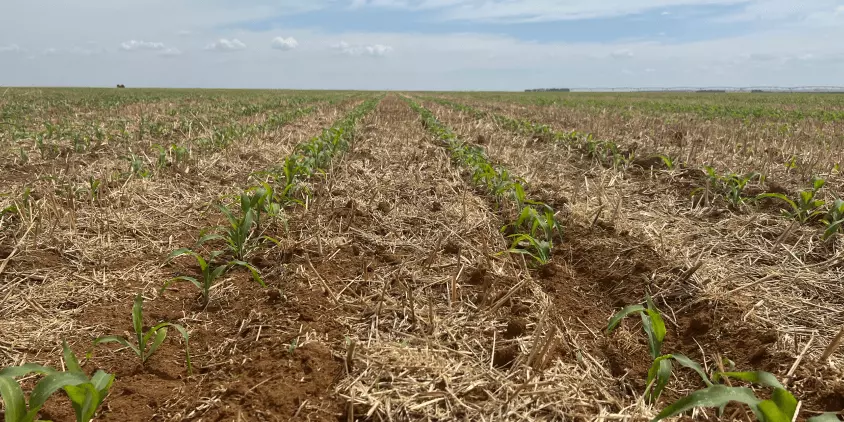
Crop Rotation
Crop rotation is a powerful agricultural technique with multiple benefits. As a method of no-till farming, it assists in the following issues:
- Weed and pest infestations. Rotation breaks weed and pest life cycles since different types of crops have different weed and pest threats.
- Soil erosion. Growing in rotation, crops with different root systems and high-residue crops are particularly helpful.
- Soil depletion. Legumes’ ability to enrich soil with nitrogen makes them an ideal crop rotation element.
To successfully implement these and other zero-till methods, it is necessary to track the field’s vegetation status, know the local weather and vegetation patterns, and be able to react to field problems in time. All of these tasks can be easily handled with the help of crop monitoring systems.
EOSDA Crop Monitoring
Performing fields analytics based on relevant satellite data to ensure effective decision-making!
Management Of No-Till Fields With EOSDA Crop Monitoring
EOSDA Crop Monitoring is a user-friendly online tool designed for remote field control and assistance in farming activities. It operates on satellite-retrieved data, enabling agriculturalists to make weighted decisions. In the light of no-till farming practices, this farm monitoring solution helps crop producers estimate the overall crop health, providing the following agriculture information:
- compares historical and real-time data on production zones;
- elaborates vegetation index charts (NDVI, NDRE, MSAVI, and ReCl);
- determines stages of plant growth;
- measures soil moisture on the surface and the root zone;
- allows distinguishing between bare zones and areas covered with vegetation to prevent erosion;
- provides weather forecasts.
Crop Rotation Planning And Precise Input Application
Even though modern farming aims for organic solutions, chemical applications remain a major worry. Because weeds grow so quickly on uncultivated lands, zero-till farmers have no choice but to use more herbicides. EOSDA Crop Monitoring aids in tackling the issue with its zoning feature, which comprises productivity and vegetation maps. Our comprehensive productivity maps serve as an invaluable tool for efficient input application and crop rotation planning by providing valuable insights into long-term vegetation patterns.
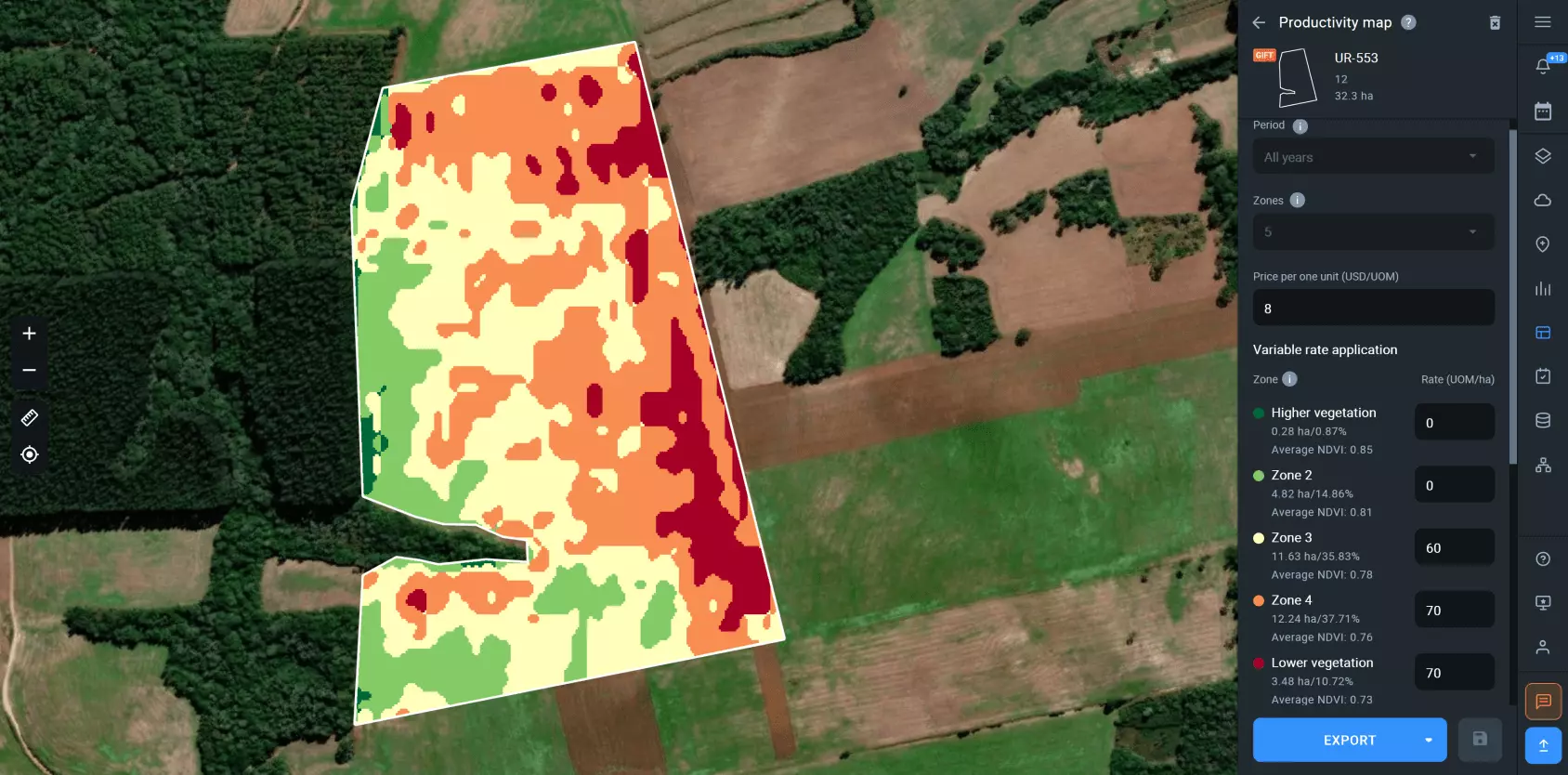
Vegetation maps outline critical areas of low crop productivity that can be a result of weed infestations or nutrient deficiency. Thanks to vegetation maps, zero-till farmers may now precisely target problem areas rather than entire fields with variable rate pesticide and fertilizer applications. Using weather data and vegetation maps, you can also compare the seasonal growth of different crops in a particular sequence to determine the efficacy of your crop rotation plan.
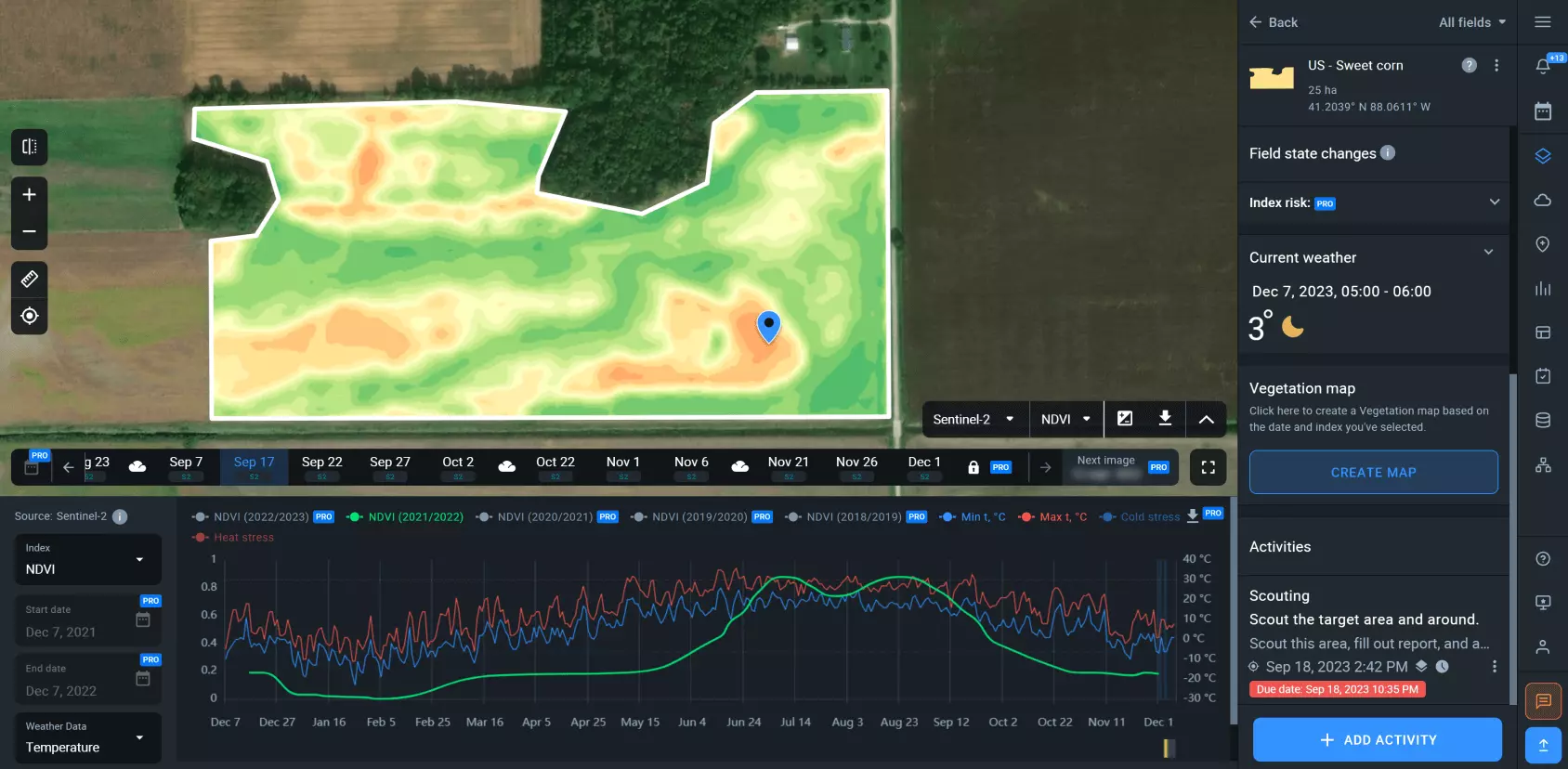
Efficient Crop Residue Management In No-Till Fields
Post-harvest crop residues or cover crops bring multiple benefits: they protect the soil from erosion, warm it up in spring, protect it from drying out, add nutrients for the next-season plants, and suppress weeds, to mention a few. Nevertheless, at the beginning of the sowing season, they are often undesired. If the residues are low, they may not require any treatment in no-till farming. On the other hand, if the area is bare or covered with scarce vegetation, more covering may be necessary. EOSDA Crop Monitoring can detect areas with increased bare ground cover, giving a farmer precious information on where exactly to apply extra residue cover to prevent soil erosion.
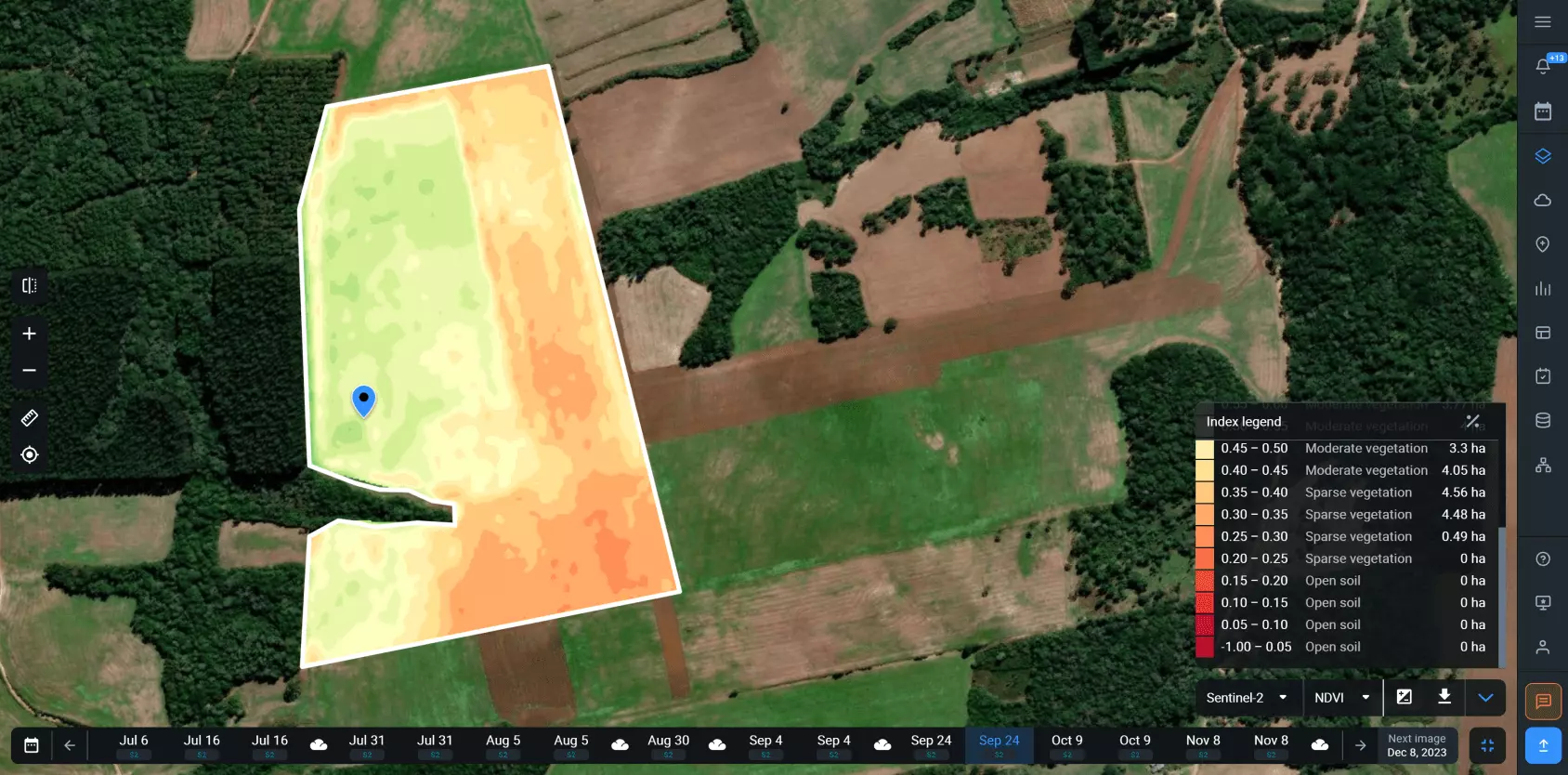
High residues prevent the ground from properly drying and warming in the spring and interfere with planter operations. For these reasons, high residues have to be removed. Conventional farming combats undesired vegetation with plowing. No-till farming excludes this method, using other crop residue management options: herbicide applications, cutting for forage, or grazing.
A typical example of double cropping in no-till farming systems is planting winter grains, crimson clover, or hairy vetch in the fall and cutting them before flowering to grow summer vegetables or mid-season brassicas in the cover crop mulch. Other sequences may include growing corn after hay or growing soybeans after wheat.
These no-till farming activities are prolific, but they require proper timing. If the terrain is dry enough, residues should be removed one to two weeks before planting. If the terrain is wet, it should be done right before planting. For optimal planning of zero tillage, use the weather and soil moisture data in EOSDA Crop Monitoring.
Sustainable Impacts Of No-Till Farming
The rise of no-till farming as a sustainable agricultural practice has been encouraging, as it promotes environmental responsibility while meeting the increasing demand for food around the world. What makes no-till farming sustainable and how does this approach contribute to an environmentally conscious future? Let’s take a look.
Improved Soil Health
No-till farming helps maintain soil structure and carbon by minimizing soil disturbance. This allows for the preservation of beneficial microorganisms and other soil life and promotes soil fertility.

How Does No-Till Agriculture Help Reduce Soil Erosion?
By causing little to no soil disturbance, no-till farming reduces soil erosion. Why is this non-disturbance important? Tillage breaks the earth’s surface and turns it over, moving the cover layer inside. As a result, the bare soil is subject to erosion because of the loosened structure. Deprived of cover matter, it is subject to quick erosion due to water flows and winds, especially in slopes and steep areas. Rainsplash erosion is another issue to consider, as the particles of bare soil are easily removed when hit by heavy rains. When the farming system doesn’t disturb the soil, none of these issues occur.
What Is The Importance Of No-Till Farming For Soil Carbon Sequestration?
Zero-till agriculture is essential for soil carbon sequestration. Let’s compare how two farming methods — conventional tillage vs. no-till farming — deal with carbon.
Through tillage, carbon is moved from the soil to the topsoil. It is beneficial for plants because the released carbon provides them with nutrients. But this carbon also reacts with the atmosphere by binding oxygen to carbon dioxide (CO2) — a terrible thing because of the greenhouse effect. In zero-till farming systems, carbon remains in place in the soil. So, no-till farming and the reduction of carbon dioxide emissions are closely related.
How Does No-Till Farming Help Conserve Soil Fertility?
Conservation of the soil and preservation of its fertility are both promoted by no-till farming. Tilling interferes with the delicate balance of Earth’s flora and fauna, impacting micro-communities. It does help mechanically control mature pests and their larvae, yet it destroys beneficial species. With zero tillage, certain soil microorganisms in their natural habitats are capable of improving soil fertility with their activities. Nitrogen enrichment by legumes is another way in which no-till farming improves soil fertility; this is especially helpful for crops that come after legumes in a crop rotation.
Enhanced Water Management And Conservation
A protective layer of crop residue is kept on the fields under zero tillage. Because it acts as a barrier that reduces evaporation and runoff, this cover keeps more water available for crop growth.
Undisturbed soil structure, as well as crop residues or mulch, also contribute to better water absorption. The enhanced ability of rainwater to percolate into the ground helps recharge underground water sources. In areas where water is scarce, increasing water infiltration is essential for making the most of this valuable resource in the long run. When the soil water availability in a particular area is low, the additional millimeters of water no-till farming provides become crucial.
Climate Change Mitigation
At the core of climate change mitigation by no-till farming is improved carbon sequestration in the soil. Another direct outcome of zero tillage is reduced fuel consumption and greenhouse gas (GHG) emissions due to the reduced soil disturbance. No-till farming, requiring less frequent and intensive use of machinery, also promotes energy efficiency and conservation. In addition to lowering GHG emissions, this fits in with broader movements towards greener and more sustainable farming practices.
Is no-till farming better for the environment? Eventually, yes; yet, observing the effect will most certainly take more time than a few growing seasons. However, as time goes on and more and more farmers start to reap the benefits, it becomes clear that the effort is worthwhile. Because of this, no-till farming will continue to gain popularity among agriculture producers and, hopefully, will soon become a standard practice.
About the author:
Vasyl Cherlinka is a Doctor of Biosciences specializing in pedology (soil science), with 30 years of experience in the field. He attended the engineering college in Ukraine and received his degree in agrochemistry, agronomy and soil science in the Chernivtsi National University. Since 2018, Dr. Cherlinka has been advising EOSDA on problems in soil science, agronomy, and agrochemistry.
Recent articles
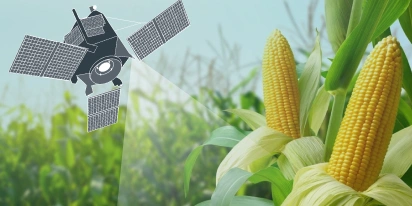
The Best Vegetation Indices For Maize Growth Monitoring
One index won’t fit every maize growth stage. Knowing which one to use and how to interpret can save you time and inputs during the growing season.
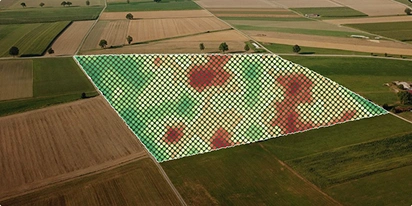
Yield Monitoring And Mapping In Precision Farming
Why do two neighboring field areas produce such different results? Yield monitoring and mapping help explain why inputs go to waste in some areas and how to manage them more efficiently.
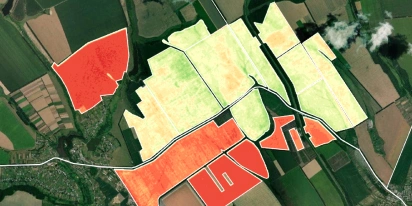
NDVI Explained: How The Index Helps Monitor Crop Health
NDVI is a trusted index for monitoring crop health. Learn how it works, what the values mean, and how to use it to guide better farm management decisions.